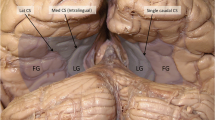Abstract
The posteroinferior region of the thalamus is formed by the pulvinar, and it is surgically accessed through the infratentorial supracerebellar approach, between the midline and the retromastoid region. This study aimed to compare the paramedian, lateral, extreme lateral, and contralateral paramedian corridors with the posteroinferior thalamus through a suboccipital craniotomy and an infratentorial supracerebellar access. Ten cadavers were studied, and the microsurgical dissections were accompanied by the measurement of the variables using a neuronavigation system. Statistical analysis was performed using analysis of variance (ANOVA). The distance between the access midpoint at the cranial surface and pulvinar varied between 53.3 and 53.9 mm, the contralateral access being an exception (59.9 mm). The vertical angle ranged from 20.6° in the contralateral access to 23.5° in the lateral access. There was a gradual increase in the horizontal angle between the paramedian (17.4°), lateral (31.3°), and extreme lateral (43.7°) accesses. But, this angle in the contralateral access was 14.6°, similar to that of the paramedian access. The exposed area of the thalamus was 125.1 mm2 in the paramedian access, 141.8 mm2 in the lateral access, and 165.9 mm2 in the extreme lateral access, which was similar to that of the contralateral access (164.9 mm2). The horizontal view angle increased with lateralization of the access, which facilitated microscopic visualization. With regard to the exposure of the microsurgical anatomy, the extreme lateral and contralateral accesses circumvent the neural and vascular obstacles at the midline, allowing a larger area of anatomical exposure.
Graphical abstract









Similar content being viewed by others
References
Choque-Velasquez J, Colasanti R, Resendiz-Nieves JC, Jahromi BR, Kozyrev DA, Thiarawat P, Hernesniemi J (2017) Supracerebellar infratentorial paramedian approach in Helsinki. Neurosurgery: cornerstones of a safe and effective route to the pineal region. World Neurosurgery 105:534–542. https://doi.org/10.1016/j.wneu.2017.06.007
Enein-Aboul H, Sabry AAE, Farhoud AH (2015) Supracerebellar infratentorial approach with paramedian expansion for posterior third ventricular and pineal region lesions. Clin Neurol Neurosurg 139:100–109. https://doi.org/10.1016/j.clineuro.2015.08.009
Figueiredo EG, Deshmukh P, Nakaji P, Crusius MU, Crawford N, Spetzler RF, Preul MC (2007) The minipterional craniotomy: technical description and anatomic assessment. Neurosurgery 61(Suppl2):256–264. https://doi.org/10.1227/01.neu.0000303978.11752.45
Figueiredo EG, Beer-Furlan A, Welling LC et al (2016) Microsurgical approaches to the ambient cistern region: an anatomic and qualitative study. World Neurosurg 87:584–590. https://doi.org/10.1016/j.wneu.2015.10.063
Iwami K, Fujii M, Saito K (2017) Occipital transtentorial/falcine approach, a “cross-court” trajectory to accessing contralateral posterior thalamic lesions: case report. J Neurosurg 127(1):165–170. https://doi.org/10.3171/2016.7.JNS16681
Jadik S, Wissing H, Friedrich K, Beck J, Seifert V, Raabe A (2009) A standardized protocol for the prevention of clinically relevant venous air embolism during neurosurgical interventions in the semisitting position. Neurosurgery 64(3):533–539. https://doi.org/10.1227/01.NEU.0000338432.55235.D3
Jakola AS, Bartek J Jr, Mathiesen T (2013) Venous complications in supracerebellar infratentorial approach. Acta Neurochir 155:477–478. https://doi.org/10.1007/s00701-012-1614-8
Kalani MY, Martirosyan NL, Nakaji P et al (2016) The supracerebellar infratentorial approach to the dorsal midbrain. Neurosurg Focus 40:VideoSuppl1:2016.1.FocusVid.15462. https://doi.org/10.3171/2016.1.FocusVid.15462
Kotwica Z, Saracen A, Kasprzak P (2017) Keyhole surgery of pineal area tumors – personal experience in 22 patients. Transl Neurosci 8:207–210. https://doi.org/10.1515/tnsci-2017-0028
Kulwin C, Matsushima K, Malekpour M, Cohen-Gadol AA (2016) Lateral supracerebellar infratentorial approach for microsurgical resection of large midline pineal region tumors: techniques to expand the operative corridor. J Neurosurg 124(1):269–276. https://doi.org/10.3171/2015.2.JNS142088
La Pira B, Sorenson T, Quillis-Quesada V et al (2017) The paramedian supracerebellar infratentorial approach. Acta Neurochir (Wien) Aug 159(8):1529–1532. https://doi.org/10.1007/s00701-017-3196-y
Matsuo S, Baydin S, Güngör A et al (2017) Midline and off-midline infratentorial supracerebellar approaches to the pineal gland. J Neurosurg 126(6):1984–1994. https://doi.org/10.3171/2016.7.JNS16277
Mbaye M, Jouanneau E, Mottolese C, Simon E (2014) Alternatives approaches to the sub-occipital transtentorial route for pineal tumors: how and when I do it? Neurochirurgie. 61:184–192. https://doi.org/10.1016/j.neuchi.2013.04.002
Meyer FB (2005) Atlas de Neurocirurgia. Acessos Básicos ao Crânio e Procedimentos Vasculares. DiLivros, Rio de Janeiro, pp 248, 273, 275
Mottolese C, Szathmari A, Ricci-Franchi AC et al (2014) Supracerebellar infratentorial approach for pineal region tumors: our surgical and technical considerations. Neurochirurgie. https://doi.org/10.1016/j.neurchi.2014.02.004
Oliveira JG, Lekovic GP, Safavi-Abbasi S et al (2010) Supracerebellar Infratentorial approach to cavernous malformations of the brainstem: surgical variants and clinical experience with 45 patients. Neurosurgery 66(2):389–399. https://doi.org/10.1227/01.NEU.0000363702.67016.5D
Porter JM, Pidgeon C, Cunningham AJ (1999) The sitting position in neurosurgery: a critical appraisal. B J Anaesthesia 82(1):117–128. https://doi.org/10.1093/bja/82.1.117
Salcman M, Heros RC, Laws ER Jr et al (2004) Kempe’s operative neurosurgery Vol II. Springer, New York, pp 21–28
Simon E, Afif A, M’Baye M, Mertens P (2015) Anatomy of the pineal region applied to its surgical approach. Neurochirurgie 61:70–76. https://doi.org/10.1016/j.neuchi.2013.11.008
Sun Q, Zhao X, Gandhi S, Tayebi Meybodi A, Belykh E, Valli D, Cavallo C, Borba Moreira L, Nakaji P, Lawton MT, Preul MC (2019) Quantitative analysis of ipsilateral and contralateral supracerebellar infratentorial and occipital transtentorial approaches to the cisternal pulvinar: laboratory anatomical investigation. J Neurosurg:1–10. https://doi.org/10.3171/2019.4.JNS19351
Yamamoto I (2001) Pineal region tumor: surgical anatomy and approach. J Neuro-Oncol 54:263–275. https://doi.org/10.1023/A:1012790213818
Yasargil MG (1996) Microneurosurgery Vol 1. Georg Thieme Verlog, Stuttgart, p 222
Yasargil MG (1996) Microneurosurgery Vol 4B. Georg Thieme Verlog, Stuttgart, p 63
Acknowledgments
We are grateful to Mr. Angelo Schuman and Mr. Rodrigo Tonan for the illustrations.
Funding
This research was supported by the authors.
Author information
Authors and Affiliations
Corresponding author
Ethics declarations
Conflict of interest
The authors declare that they have no conflict of interest.
Ethics approval
Institutional review board approval was obtained.
Consent to participate
Consent was not obtained given that presented data corresponding to the corpses are anonymized, there is no risk of identification, and the authors was under institutional ethics approval.
Consent for publication
The authors are the owners of the illustrations and give consent for publication in this journal.
Code availability
Not applicable.
Additional information
Publisher’s note
Springer Nature remains neutral with regard to jurisdictional claims in published maps and institutional affiliations.
Rights and permissions
About this article
Cite this article
de Oliveira Manduca Palmiero, H., Solla, D.J.F., dos Santos, L.B. et al. Anatomic, qualitative, and quantitative evaluation of the variants of the infratentorial supracerebellar approach to the posteroinferior thalamus. Neurosurg Rev 44, 2309–2318 (2021). https://doi.org/10.1007/s10143-020-01405-0
Received:
Revised:
Accepted:
Published:
Issue Date:
DOI: https://doi.org/10.1007/s10143-020-01405-0




